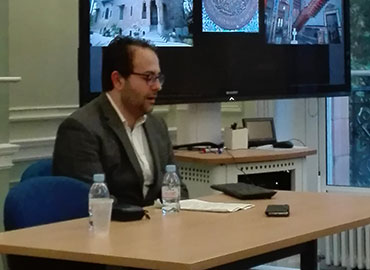|
19/10/2017
MBI Al Jaber Lecture Series: “A Return to Arabian Art and Architecture in Twentieth Century Cairo” by Dr Sami de Giosa
 |
| Dr Sami de Giosa, Fellow at the Khalili Research Centre, University of Oxford |
Dr de Giosa started his lecture by speaking about Prince Mohammad Ali Tewfik, who was a central figure in Egypt’s re-discovery of its Islamic and Arabian architectural heritage. This lecture was co-hosted by the MBI Al Jaber Foundation and the British Foundation for the Study or Arabia (BFSA).
Prince Mohammad Ali Tewfik was educated abroad (in Switzerland and France) and was a great patron of the arts. In fact, ha had to depict himself as valid monarch-to-be, given that he had been Crown Prince for a long time before being replace by his brothers’ descendants.
He had his palace, the ‘Manial Palace’, built on the Island of Roda, in Cairo. It was filled with the most refined pieces of furniture from all over the Middle East, and from the Ottoman Empire. The structure was surrounded by vast, lush gardens, for a total amount of several hundreds of square metres.
The Palace was composed of a wide variety of styles: Ottoman, Andalusian, Mamluk and Fatimid, and its construction was the starting point of the movement of revival of Arabian architecture in the last century. The architects the Prince employed were Arabs who had completed their education in Europe and the calligraphers who contributed to the decoration of the buildings were chosen from amongst the best in the country.
The inspiration is likely to have come to the Prince during his travels, therefore drawing him to replicate what he had seen in other ancient Arabian palaces. He followed the model of a royal palace developing around a mosque, which should be at the very heart of the whole structure.
The ultimate decision of the Prince was to donate the whole complex to the Egyptian state, as there was no plan for a museum dedicated to the history of Islamic art and civilisation in Cairo yet (whereas the Pharaonic Museum had almost been completed). The Palace was, therefore, turned into a museum and its gardens into a public park.
The enthusiastic audience had a good number of interesting questions the Q&A session that followed the presentation. We want to thank to Dr Sami de Giosa for sharing his amazing work with us!
For further information, please contact:
Director Public Relations
[email protected] |


